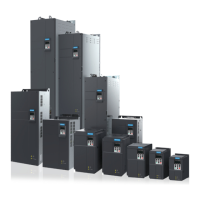8. Peripherals and Options
- 224 -
8.2 Braking Unit and Braking Resistor
■
Selection of Resistance of Braking Resistor
The AC drive transfers regenerative energy generated during braking of motor to external
braking resistor.
According to formula U x U/R = Pb:
● U refers to braking voltage at system stable braking.
● U value varies with the system. The 400 VAC power system usually selects 700 V braking
voltage.
● Pb refers to braking power.
■
Selection of Power of Braking Resistor
In theory, power of braking resistor is the same as braking power. But in consideration of de-
rating, power of braking resistor is calculated from the following formula:
K × Pr = Pb × D
● K ranges from 15% to 30%.
● Pr refers to power of braking resistor.
● D refers to braking frequency (percentage of regenerative process to whole deceleration).
The following two formulas can be obtained:
K × Pr = Pb × D = (U × U)/(R × D)
Pr = (U × U × D)/(R × K)
The user can calculate braking resistor power. K is derating coefcient of braking resistor. Low
K value can ensure that braking resistor does not get overheated. The K value can be increased
appropriately on the condition of good dissipation and should not exceed 30%. Failure to comply
may result in a re due to overheating of braking resistor.
Braking frequency (D) is determined by application. Typical values of braking frequency in
different applications are listed in the following table.
Application Elevator Winding &
unwinding
Centrifuge Occasional
braking load
General
Application
Braking
Frequency
20% to 30% 20% to 30% 50% to 60% 5% 10%

